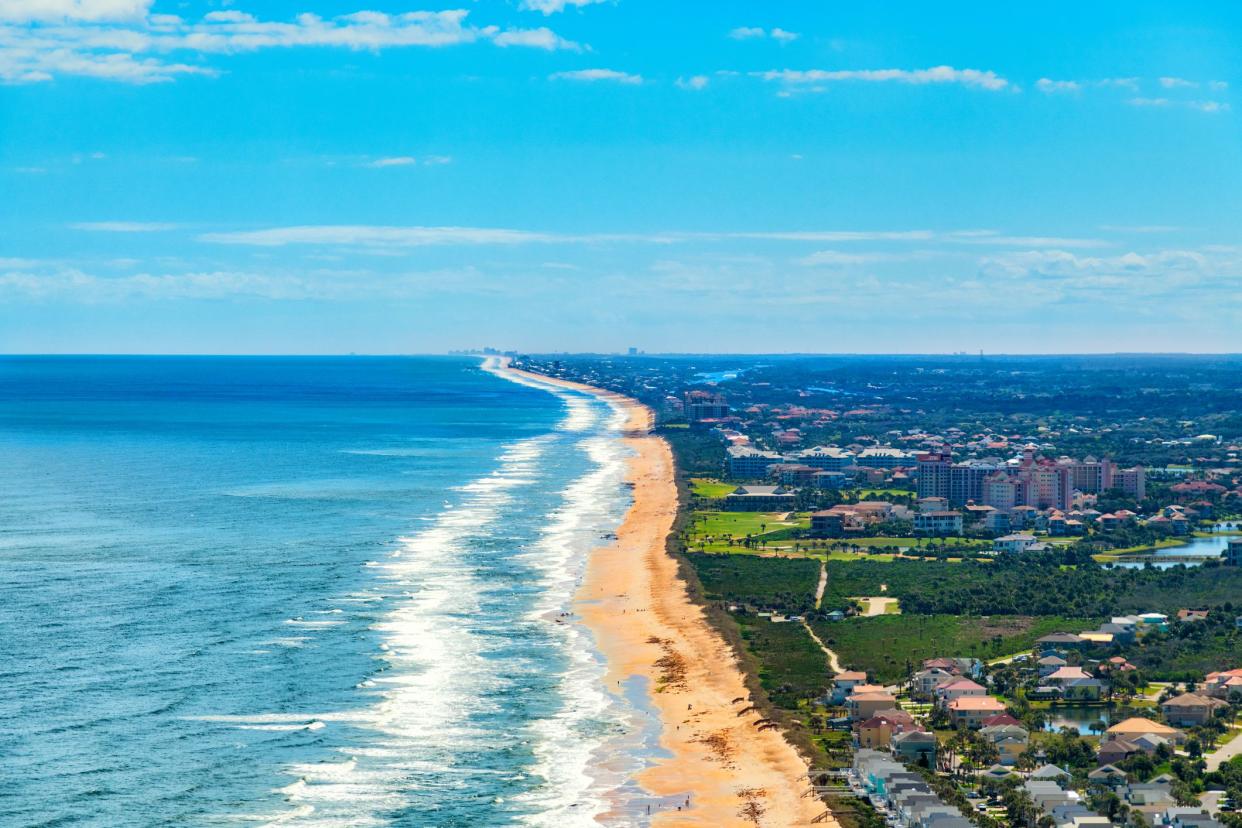Don't Know Who Regulates Your Bank? (You Should)

If you’re curious about how banks are regulated and your money is protected, it’s important to understand that multiple agencies help keep America’s financial institutions safe and compliant with the law. Some of the key regulatory agencies you may hear about are the Office of the Comptroller of the Currency (OCC), the Federal Reserve (the Fed), and the Federal Deposit Insurance Corporation (FDIC), although there are others involved as well.
This topic has been in the spotlight recently. You may have read the headlines and wondered who those agencies were and how they knew when to spring into action to help ensure that customers’ finances didn’t suffer.
Here, you can learn more about how bank regulation works, including:
What is the history of bank regulation?
What exactly do bank regulators do?
Who regulates banks?
What Do Bank Regulators Do?
Now that you have read about a few of the critical moments in U.S. banking regulation history, you may be interested to get a little more insight into what bank regulation accomplished during the ups and downs of America’s economy.
Here are some of the key points to know about what bank regulators do and how they can provide a sense of financial security:
Review the financial health of banks and step in as they deem necessary
Regulate foreign banks that are in business in the United States
Examine banks to make sure their practices are safe, sound, and fair
Intervene if banks are failing and ensure that depositors are protected up to the limits of insurance (and sometimes beyond, as mentioned above).
Who Regulates Banks?
The next aspect to delve into is who has the responsibility of regulating banks and can intervene when they deem necessary. Here are the three key players when it comes to oversight of commercial banks:
Office of the Comptroller of the Currency
The Office of the Comptroller of the Currency (OCC) is an independent bureau within the U.S. Department of the Treasury. Its role is to charter, regulate, and supervise America’s national banks and federal savings associations.
In addition, the OCC oversees federal branches and agencies of foreign banks doing business on U.S. soil.
The OCC describes its mission as:
Ensuring that these institutions conduct business in a safe and sound manner
Determining that there is equitable access to financial services and customers are treated fairly
Making certain that the banks it oversees are complying with all applicable laws and regulations.
The Federal Reserve
The Federal Reserve, or the Fed, is responsible for regulating a different set of entities: some state chartered banks, certain nonbank financial institutions, bank and financial holding companies, and foreign banking organizations.
The Federal Reserve is America’s central bank, and has a broad jurisdiction as it works to promote the health of the U.S. economy and the stability of the financial system. Among its key functions are:
Conducting on-site and off-site examinations of banks to make sure they are operating in accordance with applicable laws.
Making sure that banks have enough capital available to withstand economic fluctuations. This can involve reviewing balance sheets, projections, and other financial materials.
Possibly reviewing “resolution plans,” which detail how a financial organization would resolve a situation in which it was in financial trouble or failed.
The Federal Deposit Insurance Corporation
As mentioned above, the FDIC plays a role in insuring its member banks so that, in the rare event of a bank failure, depositors are covered for $250,000 per account holder, per ownership category, per insured institution.
However, the FDIC does more than this. It also supervises state-chartered banks that are members of the Federal Reserve. It this capacity, it oversees more than 3,500 banks, and does the following:
Checks for safe and sound operations
Examines institutions to be sure they are complying with consumer protection regulations and laws.
A Brief History of Bank Regulation
America’s banking history has taken some twists and turns, as regulation has gone in and out of favor. Here are some key points in U.S. banking to consider:
In 1791, the First Bank of the United States was created, but its charter was not renewed in 1811. The reason? While the bank provided some stability to the new nation’s economy, people worried that it put too much financial control in the hands of the federal government.
State banks began to flourish and funded the War of 1812, but, with a large amount of credit being extended, the federal government stepped in again, chartering the Second Bank of the United States in 1816.
There were again worries that the federal government had too much power over the nation’s purse strings. In 1836, the Second Bank was dissolved.
An era of free banking emerged, without federal oversight or, in many cases, the need to have an official charter to do business. The federal government tried to rein this in with the National Banking Act of 1863; the OCC was formed to charter banks and ensure that they backed their notes with U.S. government securities.
The next few decades were a bit of a bumpy ride, with bank panics, such as the Panic of 1907, occurring. The Federal Reserve was created in 1913 to help bring order to the economy.
With the debilitating Great Depression, which began in 1929, new regulations were needed. The FDIC was formed in 1933 to help shore up the faltering economy.
More recently, after a period of deregulation, the government responded to the financial crisis of 2007 and the subsequent Great Recession
It passed the Dodd-Frank Wall Street Reform and Consumer Protection Act of 2010, designed to improve accountability and financial transparency in America’s financial system.
In 2021, President Biden signed an executive order that charged federal regulators with improving their oversight of bank mergers, as part of a larger effort to increase competition in the country’s economy.
An example of financial regulation in action occurred in mid-March 2023, when the federal government stepped in as two banks faltered. The government even took the step of guaranteeing deposits over the typical FDIC insurance maximum of $250,000 per depositor, per ownership category, per insured institution.
Who Regulates Credit Unions?
Not everyone, however, keeps their accounts at a bank. There are other financial institutions, such as credit unions.
If you have an account (or multiple accounts) at a credit union, the institution that holds your money will be regulated at either the state or federal level. The National Credit Union Administration (NCUA) has oversight of federal credit unions. State-chartered credit unions are regulated by their state.
Also, credit union accounts can be insured by NCUA vs. FDIC. It’s NCUA that provides $250,000 coverage per depositor, per ownership category, per insured institution.
Who Regulates Savings and Loan Associations?
As of 2023, there are 624 savings and loan associations (sometimes called “thrifts”) operating in the U.S. While these financial institutions used to be federally regulated by the Office of Thrift Supervision (OTS), that bureau ceased to operate in 2010.
Now, savings and loans are regulated by the Fed and the OCC. These organizations are tasked with ensuring the thrifts are following the applicable laws and operating safely and soundly.
How Do I Know Who Regulates My Bank?
If you are curious about how your own bank is regulated, you can try the following, which will narrow down the field somewhat. The OCC, which regulates national banks and savings associations, has a “Who Regulates My Bank?” website.
If you don’t get the answer you are seeking there, you can call the OCC Customer Assistance Group at 800-613-6743 for further assistance.
The Takeaway
Banking regulation helps keep our financial institutions safe and sound and compliant with the appropriate laws. It also helps protect our economic stability and consumers’ deposits.
Several agencies are involved in banking regulation, such as the Fed, FDIC, OCC, and NCUA. While they rarely need to take action such as overseeing a bank closure, it can be wise to know who they are and how they function. This can help you feel more secure, knowing that they are there, backing you up; transparency in financial matters is important.
This article originally appeared on SoFi.com and was syndicated by MediaFeed.org.
SoFi® Checking and Savings is offered through SoFi Bank, N.A. ©2023 SoFi Bank, N.A. All rights reserved. Member FDIC. Equal Housing Lender.
The SoFi Bank Debit Mastercard® is issued by SoFi Bank, N.A., pursuant to license by Mastercard International Incorporated and can be used everywhere Mastercard is accepted. Mastercard is a registered trademark, and the circles design is a trademark of Mastercard International Incorporated.
SoFi members with direct deposit activity can earn 4.60% annual percentage yield (APY) on savings balances (including Vaults) and 0.50% APY on checking balances. Direct Deposit means a deposit to an account holder’s SoFi Checking or Savings account, including payroll, pension, or government payments (e.g., Social Security), made by the account holder’s employer, payroll or benefits provider or government agency (“Direct Deposit”) via the Automated Clearing House (“ACH”) Network during a 30-day Evaluation Period (as defined below). Deposits that are not from an employer or government agency, including but not limited to check deposits, peer-to-peer transfers (e.g., transfers from PayPal, Venmo, etc.), merchant transactions (e.g., transactions from PayPal, Stripe, Square, etc.), and bank ACH funds transfers and wire transfers from external accounts, do not constitute Direct Deposit activity. There is no minimum Direct Deposit amount required to qualify for the stated interest rate.
SoFi members with Qualifying Deposits can earn 4.60% APY on savings balances (including Vaults) and 0.50% APY on checking balances. Qualifying Deposits means one or more deposits that, in the aggregate, are equal to or greater than $5,000 to an account holder’s SoFi Checking and Savings account (“Qualifying Deposits”) during a 30-day Evaluation Period (as defined below). Qualifying Deposits only include those deposits from the following eligible sources: (i) ACH transfers, (ii) inbound wire transfers, (iii) peer-to-peer transfers (i.e., external transfers from PayPal, Venmo, etc. and internal peer-to-peer transfers from a SoFi account belonging to another account holder), (iv) check deposits, (v) instant funding to your SoFi Bank Debit Card, (vi) push payments to your SoFi Bank Debit Card, and (vii) cash deposits. Qualifying Deposits do not include: (i) transfers between an account holder’s Checking account, Savings account, and/or Vaults; (ii) interest payments; (iii) bonuses issued by SoFi Bank or its affiliates; or (iv) credits, reversals, and refunds from SoFi Bank, N.A. (“SoFi Bank”) or from a merchant.
SoFi Bank shall, in its sole discretion, assess each account holder’s Direct Deposit activity and Qualifying Deposits throughout each 30-Day Evaluation Period to determine the applicability of rates and may request additional documentation for verification of eligibility. The 30-Day Evaluation Period refers to the “Start Date” and “End Date” set forth on the APY Details page of your account, which comprises a period of 30 calendar days (the “30-Day Evaluation Period”). You can access the APY Details page at any time by logging into your SoFi account on the SoFi mobile app or SoFi website and selecting either (i) Banking > Savings > Current APY or (ii) Banking > Checking > Current APY. Upon receiving a Direct Deposit or $5,000 in Qualifying Deposits to your account, you will begin earning 4.60% APY on savings balances (including Vaults) and 0.50% on checking balances on or before the following calendar day. You will continue to earn these APYs for (i) the remainder of the current 30-Day Evaluation Period and through the end of the subsequent 30-Day Evaluation Period and (ii) any following 30-day Evaluation Periods during which SoFi Bank determines you to have Direct Deposit activity or $5,000 in Qualifying Deposits without interruption.
SoFi Bank reserves the right to grant a grace period to account holders following a change in Direct Deposit activity or Qualifying Deposits activity before adjusting rates. If SoFi Bank grants you a grace period, the dates for such grace period will be reflected on the APY Details page of your account. If SoFi Bank determines that you did not have Direct Deposit activity or $5,000 in Qualifying Deposits during the current 30-day Evaluation Period and, if applicable, the grace period, then you will begin earning the rates earned by account holders without either Direct Deposit or Qualifying Deposits until you have Direct Deposit activity or $5,000 in Qualifying Deposits in a subsequent 30-Day Evaluation Period. For the avoidance of doubt, an account holder with both Direct Deposit activity and Qualifying Deposits will earn the rates earned by account holders with Direct Deposit.
Members without either Direct Deposit activity or Qualifying Deposits, as determined by SoFi Bank, during a 30-Day Evaluation Period and, if applicable, the grace period, will earn 1.20% APY on savings balances (including Vaults) and 0.50% APY on checking balances.
Interest rates are variable and subject to change at any time. These rates are current as of 10/24/2023. There is no minimum balance requirement. Additional information can be found at Sofi.
Financial Tips & Strategies: The tips provided on this website are of a general nature and do not take into account your specific objectives, financial situation, and needs. You should always consider their appropriateness given your own circumstances.
External Websites: The information and analysis provided through hyperlinks to third-party websites, while believed to be accurate, cannot be guaranteed by SoFi. Links are provided for informational purposes and should not be viewed as an endorsement.
More from MediaFeed:
The Average Credit Score in Your State (How Do You Measure Up?)

As a whole, the average US credit score in 2022 was 716.
Given that a score between 670-739 is considered good credit and there was an average five-point increase from 2020, it shows many Americans are on the right track.
But to go even deeper here’s the average credit score in every state based on the most recent data from Experian.
kitzcorner // istockphoto
Average Credit Score: 691
At 25 points below the national average, Alabama has the third-lowest average credit score on our list.
That said, it did rise by five points from 2020 to 2021, jumping from 686 to 691, indicating that it’s heading in a positive direction.
benedek/istockphoto
Average Credit Score: 717
With a score of 717, Alaska is one of the higher-ranking states on our list and isn’t too far from reaching very good credit status, which starts at 740.
Also, the average credit score increased by three points from 714 in 2020.
filo/istockphoto
Average Credit Score: 710
Rising four points from 706 to 710 year-over-year, Arizona residents have maintained a solid average credit score.
They’re right in the heart of the good credit range of 670-739 and are following a positive trajectory.
4kodiak/istockphoto
Average Credit Score: 694
At 694, Arkansas is one of the 10 states in the US that had a score of under 700 in 2021.
However, like every single state on our list, Arkansas has seen its average credit score rise, increasing by four points from 690 in 2020 to 694 in 2021.
dlewis33/istockphoto
Average Credit Score: 721
While not quite as high as some other states, California clocked a healthy score of 721 on average.
There was also a five-point bump from 716 in 2020, situating it fairly close to very good credit territory.
Michael Valdez/istockphoto
Average Credit Score: 728
Speaking of healthy credit scores, Colorado collectively hit 728 in 2021, which was up three points from 725 in 2020.
This makes Colorado one of the highest-ranking states on our list and means most of its residents are spending responsibly.
Jonathan Ross/istockphoto
Average Credit Score: 728
Also at 728, Connecticut ties Colorado with its average credit score and shows it’s definitely doing something right when it comes to spending.
Note that the score also saw a healthy increase of five points year-over-year from 723 in 2020.
DenisTangneyJr/istockphoto
Average Credit Score: 714
Delaware falls right about in the middle of our list with its average credit score.
It’s considerably higher than some states in the 680s but not as high as states in the 730s or higher.
As for growth between 2020 and 2021, Delaware’s collective score rose by four points from 710 to 714.
Songquan Deng/shutterstock
Average Credit Score: 706
With a score of 706, Florida ranks as one of the lower scores on our list—something I found a bit surprising given it ranks eighth in the country for overall economic outlook.
However, it still sits respectably in the good credit range, and Floridians saw their average score increase by five points over the past year.
Art Wager/istockphoto
Average Credit Score: 693
Georgia is one of a smaller group of states that failed to reach a 700 credit score in 2021. In fact, it’s one of the lowest scores on the list.
That said, there was positive growth year-over-year, rising by four points from 689 in 2020.
SeanPavonePhoto/istockphoto
Average Credit Score: 732
Sitting at 732 in 2021, Hawaii ranks in the top ten on our list and saw a five-point increase from 727 in 2020.
Clearly, Hawaiians understand credit best practices, are smart spenders, and are following a positive trajectory.
Art Wager/istockphoto
Average Credit Score: 725
Not too far behind Hawaii is Idaho with an average credit score of 725.
This state also saw a five-point increase year-over-year, going from 720 in 2020 to 725 in 2021, indicating good spending habits and positive credit growth.
knowlesgallery
Average Credit Score: 719
With a score of 719, Illinois sits solidly on the list.
While there was only a three-point increase from 716 in 2020, which was lower than many other states, Illinois is definitely heading in the right direction.
Sean Pavone/istockphoto
Average Credit Score: 712
Indiana ranks right in the middle for the average credit score among states in America.
Like many others, it saw a five-point increase from 707 in 2020 to 712 in 2021, indicating its residents are adopting smarter spending habits.
Ultima_Gaina/iStock
Average Credit Score: 729
Sitting at 729 in 2021, Iowa had one of the more impressive average credit scores in the US.
In terms of year-over-year growth, there was a three-point increase from 726 in 2020, meaning it’s looking good overall.
JoeChristensen
Average Credit Score: 721
Not too far behind Iowa is Kansas, boasting a respectable score in its own right of 721.
Like every state on this list, there was an increase in average credit score, jumping four points from 717 in 2020, marking a decent improvement.
Michael Pham
Average Credit Score: 702
Kentucky barely hit the 700 credit score threshold, reaching 702 in 2021.
While there’s certainly room for improvement in this state, there was solid growth from the 698 score the prior year, showing Kansas is moving in the right direction.
Thomas Kelley
Average Credit Score: 689
At just 689, Louisiana had the second-lowest average credit score in America in 2021 after Mississippi at 681.
There was, however, a five-point increase, which is promising. But Louisianans are great candidates for tradelines to help raise their credit scores.
DepositPhotos.com
Average Credit Score: 727
Maine is one of the few states that experienced a six-point increase in average credit score, rising from 721 in 2020 to 727 in 2021.
Combine that with having one of the higher scores on this list, and Maine is an extremely healthy state when it comes to credit.
DepositPhotos.com
Average Credit Score: 716
Sitting at 716, Maryland is right in the middle of US states and saw a four-point increase year-over-year, climbing from 712 in 2020.
By this data, Maryland is looking good and inching its way toward having a very good credit score.
Pixabay.com
Average Credit Score: 732
At just 10 points less than Minnesota, which is the top state in the country, Massachusetts has one of the highest average scores at 732.
This puts them in the top ten on the list, and it’s only eight points from reaching very good credit.
There was also a three-point increase from 729 in 2020.
DepositPhotos.com
Average Credit Score: 719
With a statewide score of 719, Michigan ranks in the middle of the US states.
Its average credit score isn’t great, but it’s still solid and saw a five-point increase, moving up from 714 in 2020.
haveseen
Average Credit Score: 742
Boasting a super impressive average credit score of 742, Minnesota is not just the highest-ranking state on our list but the only state with a very good credit score.
There was also a three-point increase, going from 2020 to 742 in 2021, which means Minnesota is still improving.
Jacob Boomsma
Average Credit Score: 681
On the other end of the spectrum is Mississippi with the lowest overall score in the United States at just 681.
This puts it just above fair credit, which ranges from 580-669. But it’s still well above a poor 550 credit score.
SeanPavonePhoto/istockphoto
Average Credit Score: 711
In 2020, Missouri had an average credit score of 707, which is okay but not great.
In 2021, that number rose four points to 711, showing an improvement, but there’s still work to be done.
DepositPhotos.com
Average Credit Score: 730
Montana is another top-performing state with an impressive score of 730, putting them just 10 points away from very good credit score status at 740.
It should also be noted that Montana’s score rose four points from 726 in 2020, putting them on an excellent trajectory.
YinYang
Average Credit Score: 731
Hitting one point higher than Montana, Nebraska also has one of the best average credit scores on our list at 731 in 2021.
This was a three-point increase from the previous year, which was 728, and Nebraskans have proven to be responsible spenders.
Matt Bills / iStock
Average Credit Score: 701
Improving from 695 in 2020 to 701 in 2021, Nevada was one of the few states that saw a six-point increase during that time frame.
That said, it still barely exceeded the 600 range, meaning there’s plenty of room for improvement.
AlizadaStudios
Average Credit Score: 734
Just six points away from the very good credit club, New Hampshire hit an average score of 734, putting it in the top ten.
Also, there was a five-point increase from 729 in 2020, meaning there are some seriously smart spenders in New Hampshire.
DenisTangneyJr
Average Credit Score: 725
While not quite as high as some states, New Jersey has a highly respectable score of 725.
And with a four-point increase from 721 in 2020, this state is clearly heading in the right direction.
aimintang
Average Credit Score: 699
New Mexico just fell short of collectively reaching 700 in 2021, which means it has one of the lowest average credit scores in the country.
It should be mentioned, however, that it did raise its score by five points from 694 in 2020.
Davel5957
Average Credit Score: 722
Being the economic powerhouse that it is, it’s unsurprising that New York has one of the better average scores in the US at 722.
And with a four-point increase from 718 in 2020, it’s following a favorable path that’s only likely to improve.
DepositPhotos.com
Average Credit Score: 707
With an average score of 707, this isn’t anything to write home about for North Carolina.
Better spending habits are in order. But on the positive side of things, there was a four-point rise in the average credit score, going from 703 in 2020.
DepositPhotos.com
Average Credit Score: 733
North Dakota was only seven points away from collectively reaching very good credit status in 2021.
It was also just nine points less than the top-ranking state of Minnesota, which was at 742 and was up three points from 730 in 2020.
This makes North Dakota an enviable state for credit scores.
DepositPhotos.com
Average Credit Score: 715
Ohio is a mid-ranking state with a decent average score of 715.
It’s not great, but it’s not terrible, and it’s gone up by four points from 711 in 2020.
espiegle/iStock
Average Credit Score: 692
At just 11 points above the lowest-ranking state of Mississippi which was 681, Oklahoma is in the bottom ten of the list.
And while there has been an improvement from 2020 when the average score was 690, that’s one of the smallest increases at just two points.
DepositPhotos.com
Average Credit Score: 731
Moving from a low average score to a much higher one, there’s Oregon which reached 731 in 2021.
That makes it one of the top states in the country, and the average score increased by four points from 727 in 2020.
HaizhanZheng
Average Credit Score: 723
Not too far below Oregon is Pennsylvania with an average score of 723.
This puts it slightly above the middle of our list, and this state increased its average score by three points year-over-year, rising from 720 in 2020.
AppalachianViews
Average Credit Score: 723
Rhode Island has the exact same average credit score as Pennsylvania at 723.
It too ranks in the middle of our list, and it saw a four-point increase year-over-year, going from 719 in 2020.
DepositPhotos.com
Average Credit Score: 693
Not all that far ahead of Mississippi, the lowest-ranking state in the US is South Carolina which only had an average score of 693.
There’s significant work to be done to simply get it to 700, but it did see a four-point jump from 689 in 2020.
SeanPavonePhoto
Average Credit Score: 733
South Dakota’s score was just nine points lower than the top-ranking state in the country, which was Minnesota at 742.
So there are definitely some smart spenders in South Dakota. It should, however, be mentioned that its score only rose two points from 731 in 2020, which was less than many other states.
DepositPhotos.com
Average Credit Score: 701
From 2020 to 2021, Tennessee collectively increased its average credit score from 697 to 701, putting it just north of the 700 mark.
But given it’s one of the lowest-ranking states in the country, there’s certainly still work to be done, and spending habits need to be improved.
NathanMerrill
Average Credit Score: 692
Texas reached a score of just 692 in 2021, putting it only 11 points ahead of the worst-ranking state of Mississippi, which was at 681.
There has been a slight improvement from 688 in 2020, but it still has a long way to go.
DepositPhotos.com
Average Credit Score: 727
At 727 in 2021, Utah is firing on all cylinders with its credit-building habits.
It saw a four-point increase from 723 in 2020, which indicates smart spending and sustained improvement.
AndreyKrav
Average Credit Score: 736
With an average score of 736, Vermont ranked second overall in the US and is just four points away from very good credit territory.
There was a five-point increase, jumping from 731 in 2020, and other states could learn a lot from Vermont.
" DonLand"
Average Credit Score: 721
Ranking a bit further down on the list but still having a respectable average credit score is Virginia.
It was 721 in 2021, which marked a four-point increase from 717 in 2020.
ABEMOS / istockphoto
Average Credit Score: 734
Another top-ten state is Washington, which ranked fourth overall with a score of 734.
This marks a four-point boost from 730 in 2020, which solidifies Washington as a state of responsible spenders.
thyegn / istockphoto
Average Credit Score: 699
Not ranking as high on the list is West Virginia, which failed to reach an average credit score of 700, plateauing at 699.
However, it did manage to improve that number by four points, which was at 695 in 2020.
DepositPhotos.com
Average Credit Score: 735
Third on the list is Wisconsin, boasting a fantastic score of 735.
There was a year-over-year increase of three points, bumping up from 732 in 2020, showing clear signs of smart spending.
DepositPhotos.com
Average Credit Score: 722
The final state on our list is Wyoming which had a solid score of 722.
It’s nothing over the top, but it’s certainly respectable, and Wyoming saw a three-point jump from 719 in 2020.
This article originally appeared on DigitalHoney and was syndicated by MediaFeed.
AnujSahaiPhotography
